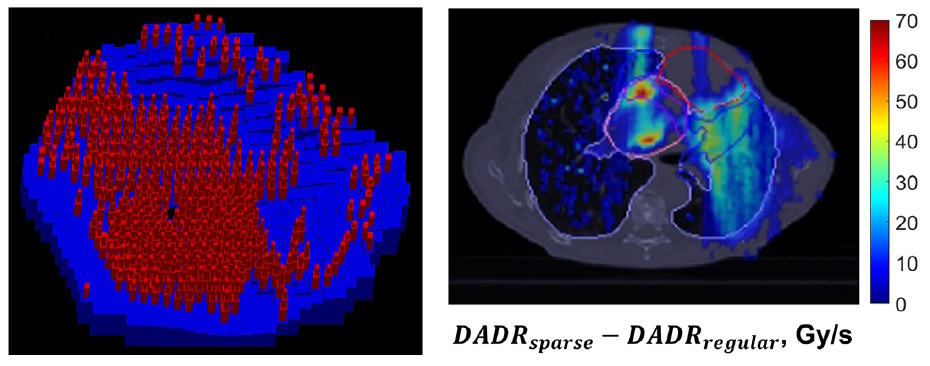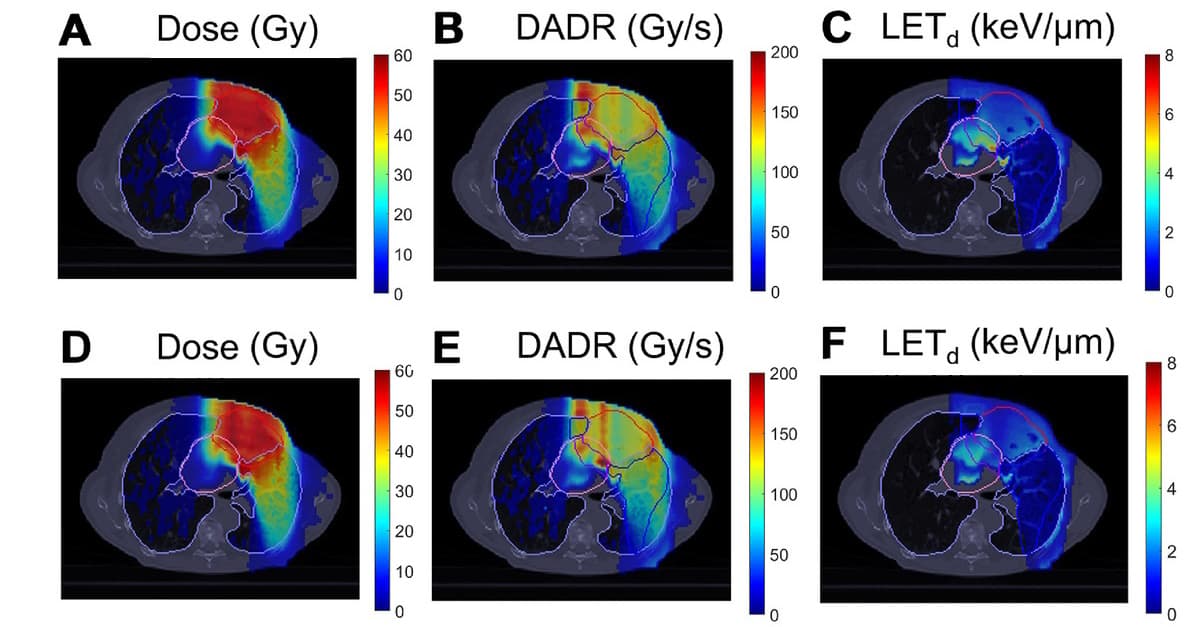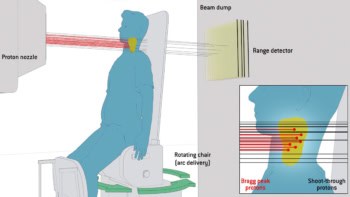
Stereotactic body radiation therapy (SBRT) is a precision cancer treatment that delivers fewer, higher-dose radiation fractions than traditional radiotherapy. SBRT can provide excellent local tumour control, but for some tumour locations it risks exposing nearby organs-at-risk (OARs) to unacceptable irradiation levels. Proton-based SBRT provides better OAR sparing, but still requires some treatment margins that may limit its clinical applicability.
FLASH radiotherapy, in which radiation is delivered at ultrahigh dose rates, could enable further sparing of OARs. To investigate its potential, a research team headed up at Emory University is developing a framework for optimizing proton therapy delivery to meet the demands of FLASH radiotherapy.
Most modern proton therapy systems can achieve FLASH dose rates using a high-energy transmission beam that passes through the patient, depositing dose throughout its path. This approach, however, eliminates the major advantage of proton therapy: its ability to deliver dose in a spread-out Bragg peak. To improve conformality at FLASH dose rates, Ruirui Liu and colleagues propose that patient-specific ridge filters could provide a similar dose distribution to that of conventional intensity-modulated proton therapy (IMPT).
For FLASH treatments, the dose, dose-averaged dose rate (DADR) and dose-averaged linear energy transfer (LETd) all influence the biological response. Thus the researchers developed an integrated physical optimization (IPO) framework that simultaneously optimizes these three parameters to maximize OAR sparing in a patient’s treatment plan. The framework, described in the International Journal of Radiation Oncology, Biology, Physics, uses the IPO-IMPT objective function to provide multiple solutions for the design of patient-specific ridge filters and proton spot maps.
The ridge filters, which are used in combination with a range compensator, comprise an array of ziggurat-shaped pins that spread the Bragg peak from a 250-MeV beam to cover a beam-specific planning target volume. The team developed inverse planning software to define the pin locations for a patient-specific filter, and used Geant4-based Monte Carlo simulations to provide dose and LET influence matrices.

Patient plans
To demonstrate the IPO-IMPT framework, the researchers developed treatment plans for three patients with lung cancer. They prescribed a dose of 50 Gy (five 10 Gy fractions) to the clinical target volume, with a maximum hotspot dose of 62.5 Gy. Depending on which parameter is prioritized, the plans aim to increase FLASH coverage and/or reduce LETd, while maintaining target dose.
For patient 1, who had a central lung tumour close to the heart, the OARs were the heart and lung. For this case, the researchers generated a single-beam IPO-IMPT plan with the aim of reducing LETd to the heart while maintaining target coverage. The IPO-IMPT plan met this goal, exhibiting similar target coverage to a conventional IMPT plan but markedly reducing LETd to the heart.

Patient 2 had a metastatic tumour in the right lower lobe and patient 3 had a tumour in the subcarinal lymph node. In these cases, the oesophagus was also an OAR and the key goal was oesophageal sparing. For both IPO-IMPT and IMPT, almost 100% of the oesophagus evaluation volume met the 40 Gy/s FLASH threshold, For patient 2, IPO-IMPT slightly decreased LETd for the heart and oesophagus and increased FLASH coverage for the heart.
Sparse pin design
Regular ridge filters designed using the IPO-IMPT framework selectively spared OARs by reducing LET and increasing FLASH coverage. However, sparse ridge filters, from which some pins are omitted, offer potential to further increase OAR sparing. Removing filter pins at specific locations delivers a higher proton flux, while the remaining pins still provide adequate target coverage.
For patient 1, the researchers generated an IPO-IMPT plan with sparse ridge filters and multiple beams. Comparison with an IMPT plan using regular ridge filters showed that, for both, tumour coverage was maintained and hotspots were well controlled. The sparse ridge filters, however, increased the OAR volume receiving a FLASH dose rate by 31% and 50%, for heart and lung evaluation volumes, respectively.
The sparse ridge filters provide flexibility to realize the full potential of the IPO-IMPT framework. For example, the pin removal levels can be tailored to individual patient cases. A 50% pin removal threshold provided reasonable results for patient 1’s large tumour, while a 30% threshold was a good starting point for the smaller targets of patients 2 and 3, whose sparse ridge filter-based plans increased DADR in the oesophagus while maintaining tumour coverage.
Finally, to verify that a ridge filter assembly (filter pins and a compensator) could deliver the predicted dose, the researchers 3D printed a patient-specific ridge filter. They delivered a treatment plan designed to provide a uniform target dose and performed dose measurements with an ionization chamber array. The total gamma passing rate was 92.9% for absolute doses, which exceeds the standard patient passing criteria of 90% and demonstrates that the assembly can deliver a clinically acceptable dose distribution.
NPL introduces absolute dosimetry for FLASH proton beams
“This proof-of-concept study demonstrates the feasibility of using an IPO-IMPT framework to accomplish FLASH stereotactic body proton therapy, accounting for dose, DADR and LETd simultaneously,” the researchers conclude. “This novel method will facilitate delivery of conformal proton fields at FLASH rates for preclinical and clinical studies.”
Senior author Liyong Lin tells Physics World that the team hopes to further develop its software for such applications. “Emory’s Office of Technology Transfer encouraged us to form a startup company, Radiotherapy Biological Optimization (RBO) Solutions,” Lin explains. “RBO is accepted by the National Institutes of Health’s Applicant Assistance Program to submit a small business technology transfer R41 grant to the National Cancer Institute by April 5. IBA, the biggest particle therapy vendor, and IBA’s dosimetry division will endorse RBO’s R41 grant proposal.”



